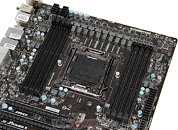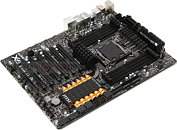- Joined
- Oct 9, 2007
- Messages
- 47,528 (7.48/day)
- Location
- Hyderabad, India
| System Name | RBMK-1000 |
|---|---|
| Processor | AMD Ryzen 7 5700G |
| Motherboard | ASUS ROG Strix B450-E Gaming |
| Cooling | DeepCool Gammax L240 V2 |
| Memory | 2x 8GB G.Skill Sniper X |
| Video Card(s) | Palit GeForce RTX 2080 SUPER GameRock |
| Storage | Western Digital Black NVMe 512GB |
| Display(s) | BenQ 1440p 60 Hz 27-inch |
| Case | Corsair Carbide 100R |
| Audio Device(s) | ASUS SupremeFX S1220A |
| Power Supply | Cooler Master MWE Gold 650W |
| Mouse | ASUS ROG Strix Impact |
| Keyboard | Gamdias Hermes E2 |
| Software | Windows 11 Pro |
MSI is among the most secretive companies with their socket LGA2011 motherboard early information as the big Sandy Bridge-E day approaches (mid-November), yet we managed to score some early pictures of their top-end product from our spy-satellites and a network of cold war era retirees. Enter the MSI Big Bang XPower II, the company's top-tier socket LGA2011 motherboard for enthusiasts. This board is designed in the XL-ATX form-factor, and will fit in cases with at least 10 expansion slot bays. Thanks to the added board area, it's able to accommodate both a strong VRM, and high room for expansion (with eight DDR3 memory slots and seven PCI-Express slots).
To begin with, the LGA2011 socket is powered by a 24-phase VRM that makes use of driver-MOSFETs, solid-chokes, and High-C POSCAP capacitors. The memory is powered by a 4-phase VRM. The board draws power, apart from the 24-pin ATX, from two 8-pin EPS connectors, and an optional 6-pin PCIe (to stabilize PCIe slot power delivery). We can see many accessories to this VRM, such as phase-loading LEDs, and consolidated voltage measurement points. We are particularly intrigued by the design of the heatsinks over the VRM and chipset. The one over the VRM looks like the barrels of a Gatling gun, while the one over the chipset looks like a small piece from an ammo belt. You will either love it or detest it.



Moving on to expansion, although the LGA2011 processor gives out 32 PCI-Express 3.0 lanes for graphics, the board is facing a lane budget deficit to wire its seven PCI-Experss x16 slots. Perhaps there is a PCI-Express bridge chip to give out additional lanes. The lane configuration is not known.
With storage connectivity, this board will give you a total of six SATA 6 Gb/s ports, from which two come from the X79 PCH, and four from additional controllers. Apart from the two 6 Gb/s ports, the X79 chipset also gives out four SATA 3 Gb/s ports. There are no eSATA ports. The board has a total of eight USB 3.0 ports, all driven by Renesas-made controllers, out of which four are on the rear panel, and four by internal headers. A nice touch here is that the front-panel headers are angled and laid beside the SATA port clusters.
The board features a high SNR (signal-noise-ratio) HD audio CODEC (probably ALC889), backed by Creative's X-Fi MB2 software that gives it even higher fidelity and more features. X-Fi MB2 software works on top of the HDA CODEC's native drivers, and so there is zero scope for any audio driver-related problems. The CODEC is wired to 8+2 channel analog outputs, optical and coaxial SPDIF outputs. There are two gigabit Ethernet connections, and surprisingly, both are driven by Intel-made gigabit Ethernet controllers. One of the two is driven by a compact 8257x series chip wired to the chipset's GbE lane, while the other is a full-fledged PCIe GbE controller. Both are backed by Intel's solid ProNetwork software and low-overhead drivers. Firewire and USB 2.0 make for the rest of the connectivity.

The MSI BigBang XPower II will be backed by a feature-rich UEFI firmware. Expect it to be among the most premium LGA2011 boards.
View at TechPowerUp Main Site
To begin with, the LGA2011 socket is powered by a 24-phase VRM that makes use of driver-MOSFETs, solid-chokes, and High-C POSCAP capacitors. The memory is powered by a 4-phase VRM. The board draws power, apart from the 24-pin ATX, from two 8-pin EPS connectors, and an optional 6-pin PCIe (to stabilize PCIe slot power delivery). We can see many accessories to this VRM, such as phase-loading LEDs, and consolidated voltage measurement points. We are particularly intrigued by the design of the heatsinks over the VRM and chipset. The one over the VRM looks like the barrels of a Gatling gun, while the one over the chipset looks like a small piece from an ammo belt. You will either love it or detest it.



Moving on to expansion, although the LGA2011 processor gives out 32 PCI-Express 3.0 lanes for graphics, the board is facing a lane budget deficit to wire its seven PCI-Experss x16 slots. Perhaps there is a PCI-Express bridge chip to give out additional lanes. The lane configuration is not known.
With storage connectivity, this board will give you a total of six SATA 6 Gb/s ports, from which two come from the X79 PCH, and four from additional controllers. Apart from the two 6 Gb/s ports, the X79 chipset also gives out four SATA 3 Gb/s ports. There are no eSATA ports. The board has a total of eight USB 3.0 ports, all driven by Renesas-made controllers, out of which four are on the rear panel, and four by internal headers. A nice touch here is that the front-panel headers are angled and laid beside the SATA port clusters.
The board features a high SNR (signal-noise-ratio) HD audio CODEC (probably ALC889), backed by Creative's X-Fi MB2 software that gives it even higher fidelity and more features. X-Fi MB2 software works on top of the HDA CODEC's native drivers, and so there is zero scope for any audio driver-related problems. The CODEC is wired to 8+2 channel analog outputs, optical and coaxial SPDIF outputs. There are two gigabit Ethernet connections, and surprisingly, both are driven by Intel-made gigabit Ethernet controllers. One of the two is driven by a compact 8257x series chip wired to the chipset's GbE lane, while the other is a full-fledged PCIe GbE controller. Both are backed by Intel's solid ProNetwork software and low-overhead drivers. Firewire and USB 2.0 make for the rest of the connectivity.

The MSI BigBang XPower II will be backed by a feature-rich UEFI firmware. Expect it to be among the most premium LGA2011 boards.
View at TechPowerUp Main Site
Last edited:







